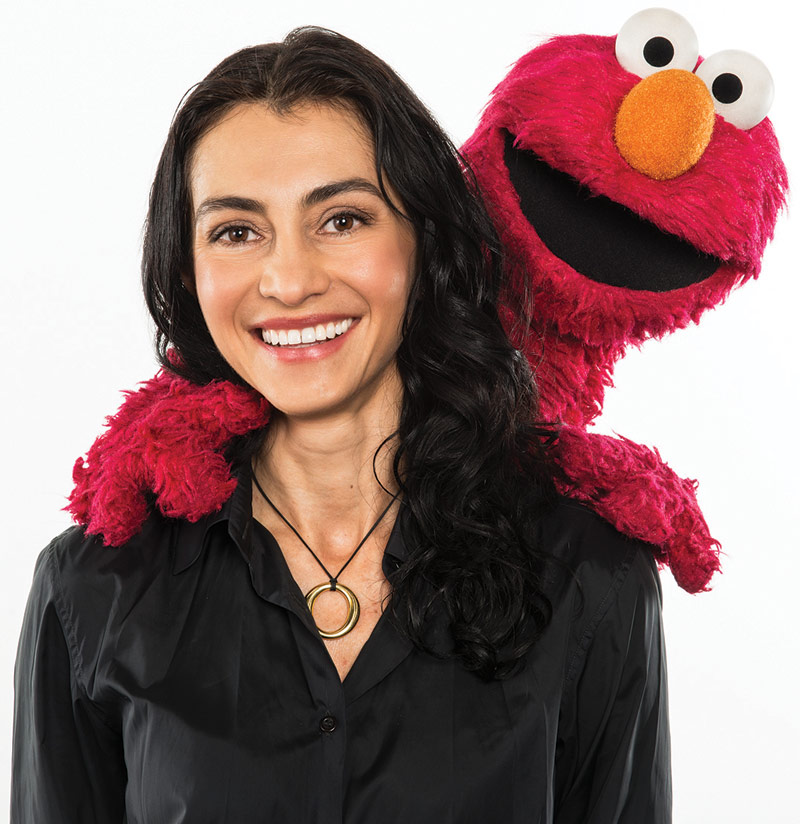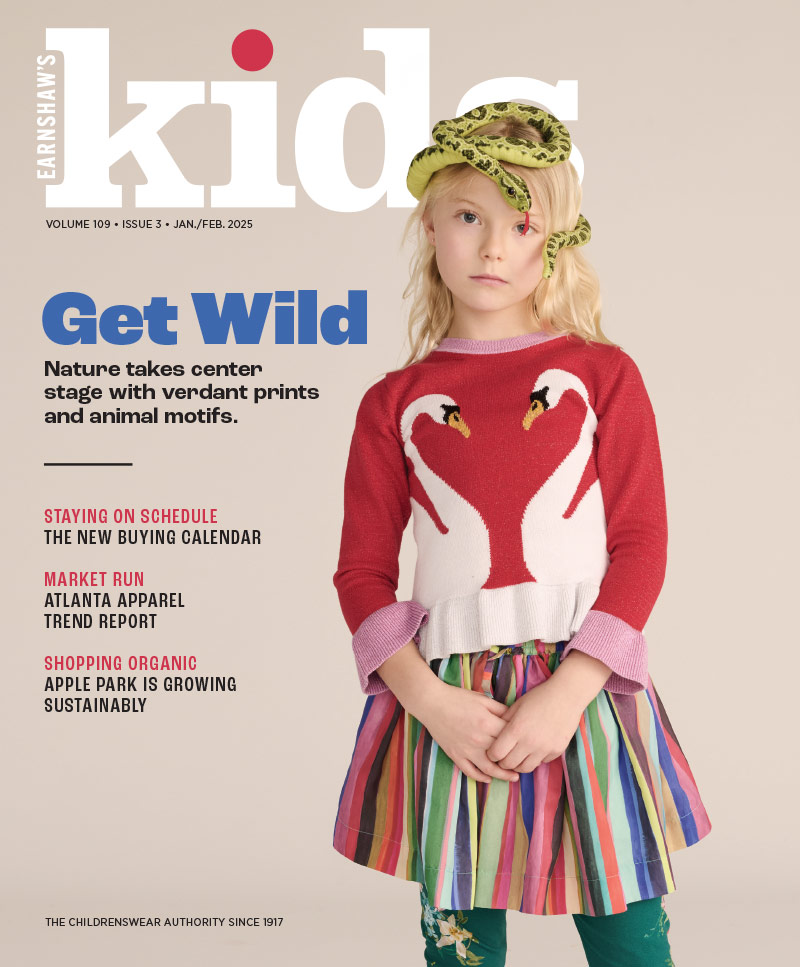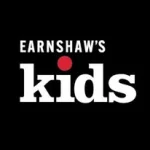Sesame Workshop’s Vice President of Licensing, Gabriela Arenas, on kiddos, fashion collabs and Cookie Monster.

Gabriela Arenas
Visit the Sesame Workshop’s headquarters in New York City, and you can’t help but feel like a giddy little kid. The T.V. show’s famously iconic opening song asks, “Can you tell me how to get to Sesame Street?” And, for most people, exactly where Sesame Street is remains a mystery. Turns out, Sesame Street is across the street from the Lincoln Center. Let’s clarify: Sesame Street, the T.V. show, is filmed at the historic Kaufman Studios in Astoria, Queens. The Sesame Workshop, its non-profit arm that tackles everything from autism to girls’ education, is located a stone’s throw away from Juilliard.
Enter the space and it’s a stimulation of the senses in kid-friendly primary colors. In the reception area, the Count, Big Bird, and Ernie and Bert greet you, staring behind frames on the wall; then they start talking to you in their widely recognizable voices and accents. Inside the office, cubicles are piled high with stuffed Elmos, Grouches, Snuffy and more. For anyone who grew up watching Sesame Street, this scene is incredibly nostalgic.
Chat Room
Do you like to read books or magazines?
Both. I love to read magazines. My favorite one is The Financial Times’ magazine
How to Spend It. I normally read in English and Spanish. I just finished Isabel Allende’s The Japanese Lover. Also in English, I just finished Leaving Time by Jodi Picoult.
If you could have dinner with a Sesame Street character, who would it be and what would you talk about?
We would talk about food. And we would talk about joy of life. And I think it would be Cookie. He’s going to eat everything, of course. At the end of the day, you never would think this: He loves his cookies, but he shares them. It’s, like, I love my bags and shoes, but I don’t know if I would share them.
If you could have a beer with someone, dead or alive, who would it be?
I don’t drink beer. So I would love to share a glass of wine with Coco Chanel. I think one of the things that I really, really admire about her is that she’s timeless and she was a rebel.
What would people be surprised to learn about you?
A lot of people think I’m an extrovert. I love parties and I love to talk. But I’m very shy. I love to cook and now I’m a yoga teacher.
Did you grow up on Sesame Street?
I grew up on Plaza Sesamo because I grew up in Mexico—with characters Abelardo, Pancho and Lola.
Sesame Street, the program, will be 50-years-old in 2019, and once only available in the U.S., now reaches more than 150 million children in more than 150 countries. The Workshop’s mission is to use the educational power of the media to help children everywhere become smarter, stronger and kinder. It recently teamed up with IBM Watson to help advance preschool education around the world. In April, the Workshop debuted its first Afghan puppet, Zari, a curious and eager 6-year-old that promotes girls’ empowerment on the local co-production of Sesame Street called Baghch-e-Simsim. And Elmo and Rosita have been dispatched to help military families transition to civilian life.
Gabriela Arenas, vice president of licensing in North America, has probably the most enviable job in the organization, developing all sorts of products to support the Workshop’s mission.
She’s the one cutting deals with Puma for a line of character-based sneakers out earlier this year. She’s the one striking partnerships with Quiksilver and Roxy for a snow gear line and accessories slated to hit stores this September. She’s the one tapping high-end California-based T-shirt company, DiLascia, for a quirky line featuring Sesame Street characters sold at Fred Segal in Los Angeles.
With a flare for fashion and a passion for dressing up dolls, Arenas, born and raised in Mexico, soon found herself in the world of licensing for childrenswear products and apparel. Earnshaw’s got a sneak peek into her magical world.
b b b
How did you get into licensing?
I came to New York from Mexico 15 years ago. When I was little I always loved to dress dolls and the whole role-play thing dressing with accessories. I’ve always been attracted to fabric, style and fashion. I got a very good opportunity from college to work at a leading toy company. Obviously, when I had the opportunity to work at [Sesame Street], it was a dream come true. I love the brand that’s been around for so many years. It’s also different to manage a brand when you’re an intellectual property holder. Not only do you go from one product to many but you have to ask yourself ‘how do you translate that brand into different categories?’ How do you translate that into fashion not only for a little kid but a mom, a tween or a teen? How does that translate in Asia? We also license food. So how do you reflect the brand with a cookie? How do you do that with a toothbrush? The beauty of the characters is that they’re very versatile and multigenerational. They can be on-trend or they can be your best friend when you’re learning to brush your teeth. That’s licensing. It’s a way of connecting with the consumer at many different touchpoints.
When people ask you where you work, what’s the reaction? Everybody has a story to tell. There’s a smile and there’s a moment—‘so you were with Cookie, what did you do?’—and everybody wants to talk about their characters. Everybody has a connection to them.
What do you love most about your job?
I love that it’s new every day. It’s never-ending. You have to ride the trends. You have to be relevant. You have to be fashionable. It’s a fine balance. And then I have to stay true to [Sesame Street] values. Sometimes it’s easier to be [a] new [company]. [In a company with history] you have a big responsibility but it’s also exciting.
What was an important lesson that you learned early on?
Trends come and go. You can totally try to do something that is on the forefront. It can be a ride for four years and then that’s it. You have to be careful. It’s a very competitive environment. And the kids, they can like you today and they don’t like you tomorrow. They can watch you today—they are going to going to learn ABCs and 123s—and they don’t watch you tomorrow. Our audience evolves every four years. And there are so many brands that start and fade, no?
How do you keep up with the trends? Do you attend trade shows? Do you attend fashion weeks?
I think [inspiration] is everywhere. It’s in the U.S. but it’s also international. I do believe there’s unbelievable talent in this office with people who are on the pulse of education, on the pulse of research, innovation, creative—How do they produce the show? What is the storyline and the narrative? What are the things that kids are facing out there? When parents get deployed, how is the family dealing with that? You’re not only on the pulse of fashion but everything that could be happening in the life of a child at that very, very important age. And how you connect with them has to be relevant, but it also has to be fun. You learn the most when you connect but also when you don’t know you’re learning. That’s the beauty of it. It also happens with [adults], when you don’t know you’re learning, you’re devouring it.
Some of these collaborations strike me as surprisingly sophisticated.
When you talk collaborations, they are best in class. There are very iconic top companies. But, again, in order to stay relevant, you have not only big-name fashion companies but up-and-coming new companies that resonate with the consumer. So you need to have a balance of both. We have partners [T-shirt company] DiLascia and Tattly, a super new and super-trendy [temporary tattoo company] in Brooklyn. And we have partners that have been with us for 30-plus years like Procter & Gamble and Random House. That’s the beauty of a brand that’s been around for generations. You grow up with the characters and then you have kids and then you connect with Sesame Street in a different way.
What companies make the best partners with Sesame Street?
You want to be true to your values. The mission cannot be diluted. That’s first and foremost what we are for and what has really maintained our DNA. If you dilute yourself, you stop being as relevant. Or maybe you stop being evergreen. And that’s a big risk. You ask yourself [what brand] aligns with you. And then I let the [creative teams] go.
How do you know what products will be a hit?
Yes, you do have an instinct and yes, you do have a gut. You’ve been in the business for a long time. But sometimes you don’t [know what will hit]. Some of those trends might not even come from the U.S. Some of the trends come from abroad. Sometimes our partners are on the pulse of a trend. Bathing Ape has a very unique look, and they interpreted our characters in the Bathing Ape type of shape. And that is something that I would have never been able to do. And it fits, and it’s amazing. It gets you thinking, ‘what else can I do similar to that?’ DiLascia is trendy and very funny. “#Hangry” on a T-shirt with Cookie. It relates to Cookie, but it’s fun and it’s clever.
Who are your retail partners?
It depends on the category. You have toys, where you really play with the characters, and those you’ll find everywhere en masse and specialty: Target, Kmart, Toys“R”Us, Wal-Mart, Amazon, you name it. The collaborations with Quiksilver and Roxy will be sold in their boutiques. We have products with Apple—there’s a T.V. app that’s available on the App Store. So again, when you connect a brand with the consumer, you have to be where the consumer is.
What are the challenges in the marketplace?
Now more than ever, you see the amount of new properties that a kid is exposed to. Not only properties coming from T.V., but properties coming from apps, digital and gaming. So there’s so much selection that the amount of time you can capture that audience is more limited. Also changing is the multiple platforms where you find the properties. In the past it used to be T.V., but now they discover them on YouTube, by a book or even a toy. So there’s so many ways to discover the brands, but also so many brands. The competitive landscape is huge. That’s good, in a way. There’s a lot of competition but competition is good. It pushes you a little bit harder. The harder the environment, the harder you try. That’s a challenge, but it’s also a thrill. You have to be out of your comfort zone sometimes. If you think about it, Sesame Street was the initial disruptor in kids’ media. When the show began, Creator Joan Ganz Cooney said, ‘It’s not whether kids are leaning from television, but what are they learning.’ And that was revolutionary. Get out of your comfort zone and try something different. It’s not easy. Sometimes it’s easier to remain where you are, no?
Do you view failure as a learning experience?
Oh, yeah. Live and learn. And then move from that. Say, ‘okay, that happened. What did we learn? What do we do better? How do we connect better? Let’s do it in a different narrative, in a different storyline.’ That’s not only in work, it’s also in life.
If you had a magic wand and could change anything about the business, what would it be?
Knowing who will be your core audience in a few years, so you can plan ahead and see where the trend is going to be before it happens. It’s not a matter of what I’d change. There’s no magic wand.
What are you doing for the show’s 50th anniversary in 2019?
One of the big milestones for us is turning 50. Turning 50 for us is going to be a big celebration. We’re expecting that in 2019. So we’re strategizing. We are American, we were created here. So which brands are celebrating 50 like us? We mentioned Gap. It would be fascinating to say, ‘okay, we started at the same time, how do we do a collection?’ A big piece of us is our mission. Who are like-minded companies that have a mission as well? One of those companies, top of mind, is Toms. So how do you do different collaborations from different angles? We’re working on that. Obviously, it’s never too early. To have a collaboration with Chanel or Moschino, that would be super fun. We’re planning ahead but also simultaneously working with H&M, Uniqlo, Puma and Quiksilver. We have a lot of things in the pipeline.
Sesame Street has always attracted A-list celebrities since the beginning. What draws them to the show?
The very first celebrity on the show was James Earl Jones. Unbelievable voice, eh? Fantastic. Obviously, we have celebrities that connect now, like Gwen Stefani. Celebrities connect with the characters. A lot of celebrities grew up with Sesame. Those celebrities are also having kids so they’re experiencing Sesame again with their kids. We collaborate with celebrities in experience more than products, I would have to say.
Where do you want to see Sesame Street decades from now?
My dream is to maintain ourselves for the next 40 years, for the next 50 years. It’s funny, when you think about it, how do you get to Sesame Street? I am here. I got here. And what am I going to do now? How do I maintain this? Yes, I’m on the product side, but in order for me to have an unbelievable product, I must have an unbelievable brand and amazing characters. There’s no product without that. I want to maintain that. You must teach kids that anything is possible. Our mission: helping kids grow smarter, stronger and kinder. Those are our values. [Partnerships] either fit or they don’t fit.




 From milestones to everyday magic, @ryleeandc
From milestones to everyday magic, @ryleeandc

 BEST IN SHOW: @milaandrose
Twirl-worthy, pla
BEST IN SHOW: @milaandrose
Twirl-worthy, pla





 This season’s
This season’s

 We had an i
We had an i


 Make Your Message Unmissable in 2025!
Get ahea
Make Your Message Unmissable in 2025!
Get ahea





 F
F



Leave a Comment: